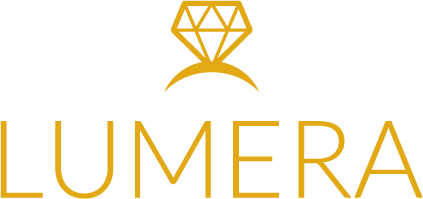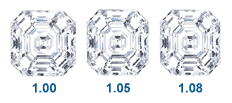Contact
Click below to speak to a Diamond Consultant or customer service.
or
Live Chat8:00 am - 6:00 pm CST (Mon - Fri)

Click below to speak to a Diamond Consultant or customer service.
or
Live Chat8:00 am - 6:00 pm CST (Mon - Fri)

The asscher cut diamond was first produced in 1902 by the Asscher Brothers of Holland, famous at the time for cutting the world's largest rough stone (the Cullinan, at 3,106 carats). Asscher cut diamonds originally peaked in popularity in the 1920's, and could recently be found only in antique jewelry shops. Around 2002, one hundred years after the first asscher cut diamond was created, the shape began to make a comeback, spurred on by cut modifications that gave the shape more brilliance than traditional asscher cut diamonds.
The modern asscher cut diamond is similar to a square emerald cut, usually with larger step facets, a higher crown, and a smaller table. This combination often produces more brilliance than the emerald cut. A well cut asscher will appear to have concentric squares as you look down through the table, the result of proper positioning of the pavilion facets underneath. Like the emerald cut, the asscher cut has cropped corners; however, because an asscher is square, the cropped corners give the asscher cut a somewhat octagonal shape. Once mounted in a four prong setting, the diamond maintains its unique shape within a square silhouette.

The classic asscher cut diamond is a square (with a length to width ratio of 1.00); however they are often found in slightly rectangular shapes as well. Any ratio of 1.05 or less will appear square to the naked eye. Every Lumera Diamond includes precise measurements, as well as the length to width ratio, so you know the exact shape of the asscher cut diamond you are considering.
The chart below serves as a general guideline for evaluating the cut of an asscher cut diamond.
| EXCELLENT | VERY GOOD | GOOD | FAIR | POOR | |
|---|---|---|---|---|---|
| Table % | 61 - 69 |
57 - 60
or 70 - 72 |
54 - 56
or 73 - 74 |
51 - 53
or 75 - 79 |
< 51
or > 79 |
| Depth % | 61 - 67 |
59 - 60.9
or 67.1 - 70 |
57 - 58.9
or 70.1 - 74 |
54 - 56.9
or 74.1 - 79 |
< 54
or > 79 |
| Girdle | Very Thin - Slightly Thick |
Very Thin
to Thick |
Very Thin
to Very Thick |
Ex. Thin
to Ex. Thick |
|
| Culet | None | Very Small | Small | Medium | > Medium |
| L/W Ratio | 1.00 - 1.03 | 1.04 - 1.05 | 1.06 - 1.08 | > 1.08 | |
Evaluating color in asscher cut diamonds is subjective. Keep in mind that many buyers may actually prefer the ever so slightly warmer colors of a G-H diamond over the cool colorlessness of a D-F diamond. In fact, most of the premium in price associated with asscher cut diamonds at the higher end of the color scale is driven by supply and demand; customers want the D-F color grades, and are willing to pay a premium to get them. In a world without diamond color grading, the price premium for higher grades would be much lower, as the actual differences in color are difficult to perceive.
Often, body color is easier to see in an asscher cut diamond (especially over 1.50 carats) because of the large, open facets. The color chart below provides a general guide for evaluating color in asscher cut diamonds.
| EXCELLENT | VERY GOOD | GOOD | FAIR | POOR | |
|---|---|---|---|---|---|
| < .50 ct. | D - G | H - I | J - K | L - M | > M |
| .51-1.0 ct. | D - F | G | H - I | J - K | > K |
| 1.0-2.0 ct. | D - F | G | H - I | > I | |
| > 2.0 ct. | D - F | G | H - I | > I | |
| Fluoro | None | Faint | Medium | Strong - Very Strong | |
Like color, evaluating clarity in asscher cut diamonds is subjective. GIA provides excellent help with their clarity grades. Still, it is important to understand that each customer will have a unique standard for clarity. Some may be perfectly comfortable with an inclusion as long as they cannot easily see it. Others may insist on a more technically flawless appearance.
Often, inclusions are easier to see in an asscher cut diamond. While an SI1-clarity might be a great balance of price and appearance in other diamond shapes, in asscher cut a VS2 might be a comparable choice. The clarity chart below provides a general guide for evaluating clarity in asscher cut diamonds.
| EXCELLENT | VERY GOOD | GOOD | FAIR | POOR | |
|---|---|---|---|---|---|
| < .50 ct. | FL - VS2 | SI1 | SI2 | I1 | > I1 |
| .51-1.0 ct. | FL - VS1 | VS2 | SI1 | SI2 | > SI2 |
| 1.0-2.0 ct. | FL - VVS2 | VS1 - VS2 | SI1 | SI2 | > SI2 |
| > 2.0 ct. | FL - VVS2 | VS1 | VS2 | SI1 | > SI1 |
Questions about shape or other aspects of a diamond? Ask a diamond consultant for answers. A consultant will answer any questions you have, and if you like, search for diamonds on your behalf that match your criteria. chat online, or send your request to consultant@lumeradiamonds.com.

